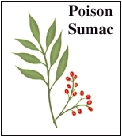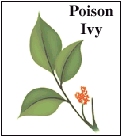Avoiding Poison Ivy, Poison Oak, and Poison Sumac
Avoiding Poison Ivy, Poison Oak, and Poison Sumac
Poison oak, poison ivy, and poison sumac are plants that can cause skin rashes. The problem is a sap oil called urushiol that is contained in these plants. If you're allergic to urushiol, touching one of these plants may cause your skin to react. Within hours or days, you may have a red, swollen, itchy rash. You can't stop the rash. But you can soothe the itching.
Recognizing these plants
You can help prevent a poison oak, poison ivy, or poison sumac rash. Know what these plants look like. And then avoid them. They grow in the form of vines, small plants, and large bushes. In most cases, poison oak and poison ivy have 3 leaves per stem. Poison sumac has from 7 leaves to 13 leaves per stem. Watch out for these plants when you go to any outdoor area, from a friend's overgrown back yard to the wilderness. Urushiol is present in these plants all year round, even when the leaves are gone. So always be on the lookout.
What causes a reaction?
Poison oak, poison ivy, and poison sumac thrive mainly in unmaintained outdoor areas. If you touch these plants, you may get a rash. You may also react if you touch something that came in contact with urushiol. This could be a dog or cat, clothing, or equipment. But the rash caused by these plants is not contagious.
Steps to prevention
When heading outdoors, take these preventive steps:
Avoid touching any of these plants.
Wear long pants and a long-sleeved shirt.
If you're going to a heavily wooded or brushy area, also put on gloves, a hat, and boots.
If you are very sensitive, apply bentoquatam 5% topical cream to all exposed areas of your skin. This creates a layer of protection between your skin and any sap oil you may touch.
If you come in contact with these plants or the oil, wash with soap and water as soon as possible.
Wash clothing and animals that come in contact with these plants as well. Urushiol may stay on them and cause a rash when you touch them in the future.
Updated:
March 21, 2017
Reviewed By:
Image reviewed by StayWell art team.,Moskowitz, Richard, MD,Sather, Rita, RN


